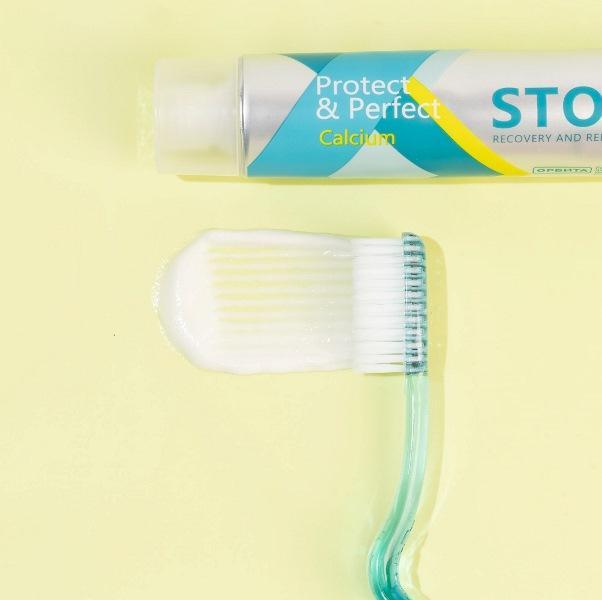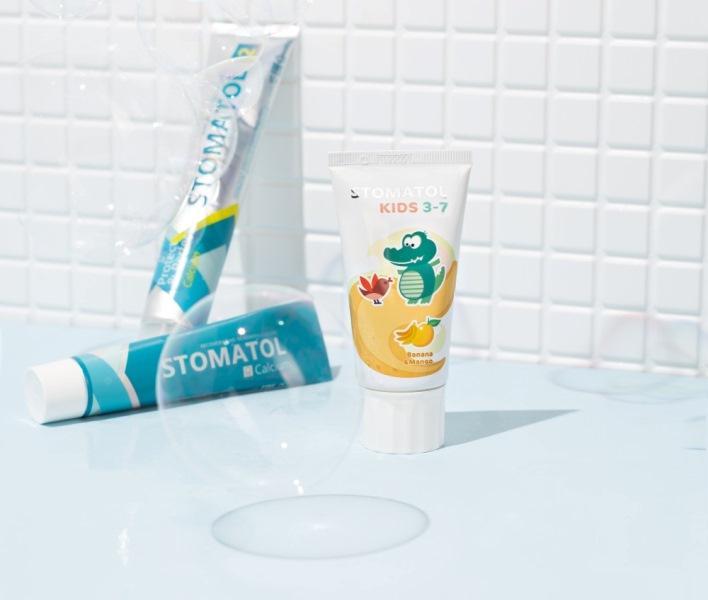Caries is one of the most common oral diseases. The development of caries is promoted by the acidic environment in the oral cavity, which is formed as a result of the vital activity of microorganisms. In turn, the number of pathogenic bacteria and their metabolic products increases with the consumption of large amounts of fast (easily fermentable) carbohydrates: sugar, chocolate, carbonated drinks. Also, the growth of bacteria is promoted by food debris in hard-to-reach places. As a result of each meal, acidity increases, which leads to demineralization of tooth enamel. In other words, when the pH of the oral cavity is low, tooth enamel is more easily susceptible to erosion and destruction. Without comprehensive protection and strengthening of enamel, its demineralization becomes irreversible under the influence of an aggressive acidic environment, which subsequently leads to the formation of caries.

STOMATOL toothpastes are modern multifunctional products. In addition to the direct cleaning function, STOMATOL products contribute to the prevention of caries and complex remineralization (enamel restoration, the reverse process of demineralization) due to the combination of sodium monofluorophosphate and calcium.

“One of the first experimental formulas for the combination of fluoride and calcium in toothpaste was developed in 1945 on the initiative of pediatric dentist Basil Bibby. Calcium carbonate (ordinary chalk) was used as the abrasive base. As a result, fluorine reacted with the base and precipitated as an insoluble precipitate of calcium fluoride. Perhaps, based on this experience, the scientific community has established the opinion that toothpastes with calcium and fluoride are ineffective.
Since the first experimental formula, the quality and variety of components, as well as the technical equipment of production, have progressed. Today we effectively use the properties of each component separately to maintain their synergy in the composition. For example, fluoride ions are more active and larger than calcium ions. Quickly integrating into the surface layers of enamel, fluoride attracts slow calcium ions both from saliva and from the composition of the paste. Thus, calcium is absorbed more slowly, but manages to penetrate much deeper and strengthens the enamel more effectively. As a result, sodium monofluorophosphate in STOMATOL toothpaste acts both as an independent anti-caries agent and as an excipient.”
Konstantin KUKLIN, biotechnologist, technologist-developer of the Stomatol brand
Fluoride in toothpastes is one of the most effective ways to protect teeth from caries and other oral diseases. Fluorine in toothpaste binds with hydroxyapatite, a mineral that forms the basis of tooth enamel, resulting in the formation of acid-resistant hydroxyfluorapatite, which by its presence strengthens the enamel and makes it less susceptible to aggressive acidic environments.
The protective and strengthening functions of fluorides are enhanced by the addition of calcium to toothpaste. The STOMATOL formula is enhanced with three forms of calcium.

Hydroxyapatite is the main component of tooth enamel and bone tissue, which has the ability to interact with the surface of the teeth and create a protective layer on it. It is also capable of sealing dentinal tubules and microcracks, which helps reduce tooth sensitivity.
Dicalcium phosphate dihydrate is an organic compound that helps prevent enamel destruction by saturating saliva with calcium and phosphate ions, replenishing calcium and phosphorus deficiency, thereby restoring enamel and increasing the resistance of oral tissues to acid.
Calcium lactate is an organic compound that helps prevent the destruction of tooth enamel by strengthening the protective layer on the surface of the teeth.
“As a result of a scientific study, it was revealed that toothpaste containing sodium monofluorophosphate in a concentration of 1000 ppm, dicalcium phosphate dihydrate and perfluorodecalin as an abrasive, has good cleansing properties, a pronounced anti-caries and anti-inflammatory effect, which has a positive effect on the hygienic condition of the oral cavity , periodontal tissue and dental health in general. This is confirmed by clinical, biochemical and microbiological indicators, as well as crystalloscopy methods. This toothpaste can be recommended both to patients with a high risk of developing a carious process, and to patients with inflammatory diseases of periodontal tissues and allows the manufacturer to declare its positive comprehensive effect on the condition of the oral cavity.”
UDC 616.31:665.583.44, Comprehensive study of toothpaste containing fluorides and abrasive – dicalcium phosphate dihydrate
The range of the STOMATOL brand is steadily expanding, offering specialists a wide range of high-quality oral hygiene products made in Russia. In October, two toothpastes “Natural therapy” and “Soft whitening” were presented. The formula of toothpastes consists of more than 97% ingredients of natural origin, enhanced with neroli and tea tree hydrolate, hyaluronic acid, which help moisturize and soften the oral mucosa.

Gentle cleansing of enamel occurs through a combination of abrasives – silicon dioxide, which gently polishes the enamel without damaging it, and dicalcium phosphate dihydrate, which regulates pH and performs a mineralizing function due to calcium and phosphorus ions.
More information about the range and composition of the brand on the official website www.stomatol.com
Advertising by IP Pustolyakov A.A. , erid:2VtzqxGaGqZ
